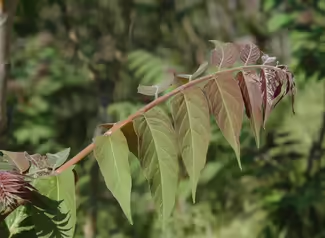Tree of Heaven Damage
Tree of Heaven is a rapidly growing tree that grows in poor soil conditions and forms colonies. It can outcompete other native vegetation and is allelopathic, meaning it releases compounds into the soil that slow the growth of other plants.
History of Tree of Heaven
Tree of Heaven was introduced to the U.S. from China in the 1700s as an ornamental plant. It was specifically planted in urban areas because of its ability to grow in poor soils. This tree serves as a host for the invasive insect Spotted Lanternfly to lay its eggs which has been documented in Illinois in 2023.
Regulation of Tree of Heaven
This plant is not regulated under Illinois law.

Tree of Heaven grows quickly and can reach heights of 80 feet. The leaf scars are large and heart shaped. Its leaves are pinnately compound and have between 10 and 41 leaflets. The base of the leaflets has a notch on both sides, and the foliage smells of rotten peanut butter when crushed.
This tree is dioecious, meaning it has separate male and female plants. Female plants produce clusters of yellow flowers in the summer. The flowers are replaced by tan-to-red samaras with a single wing.


- Mechanical removal: Repeated mowing of small plants may exhaust root systems, but larger plants should not be cut as this will cause root suckering and increase the infestation. Instead, large plants should be chemically treated. Small plants can be pulled; larger plants or plants that are part of a larger root system (clonal growth) cannot be removed by pulling or digging.
- Fire: Seedlings may be killed by prescribed fire. Plants older than seedling stage should not be burned without treating with herbicide first. Top killing plants will cause root suckering.
- Chemical control: Always read and follow the herbicide label before initiating treatment.
- Foliar: Apply 1% to 3% volume-to-volume, v/v, glyphosate in water or 1% to 2% v/v triclopyr in water during the growing season when plants are actively growing and before fall leaf color change.
- Basal bark: Apply a triclopyr ester formulation at a 20% v/v rate, mixed with basal oil, to the lowest 15 inches of the stem.
- For larger trees, girdle or frill the stem and apply herbicide directly into the cut surface.
For more information, explore Management of Invasive Plants and Pests of Illinois.



